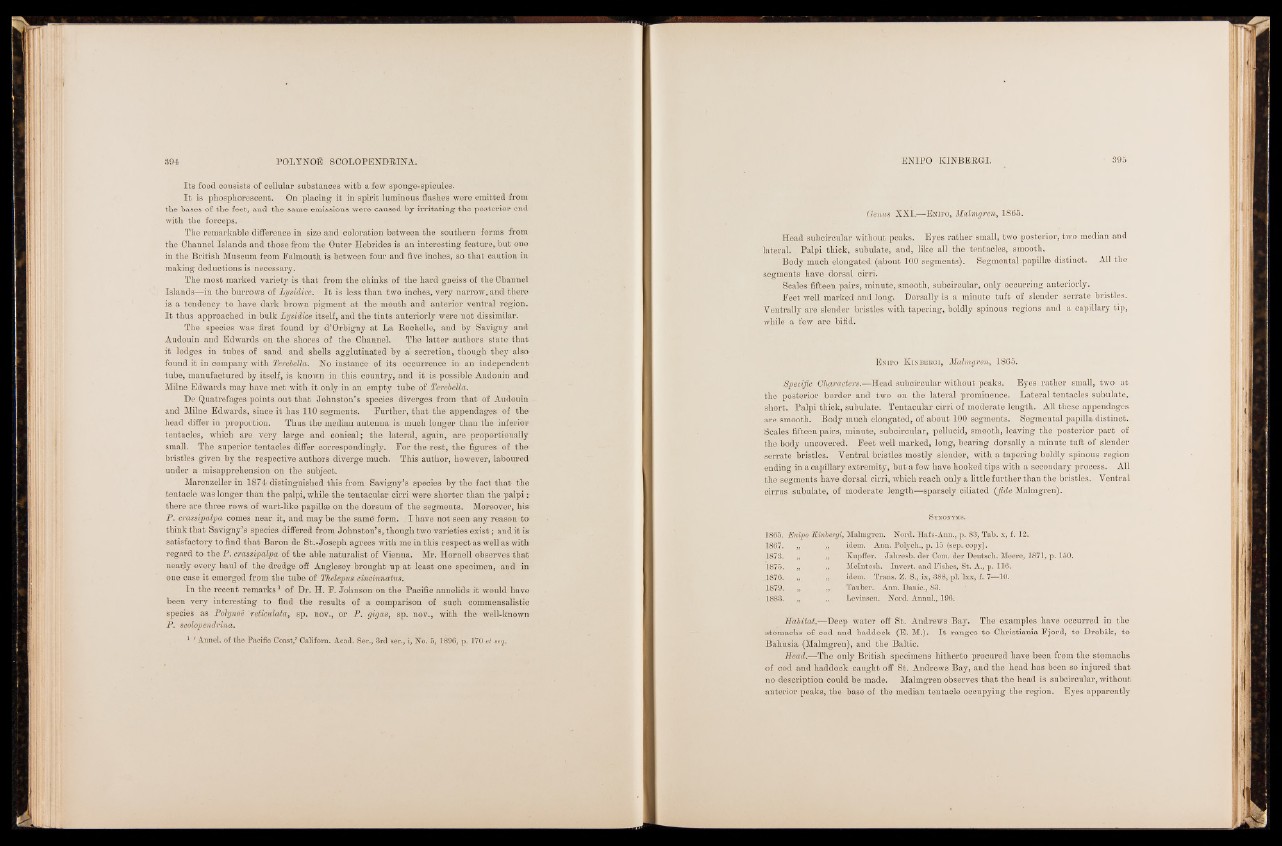
Its food consists of cellular substances with a few sponge-spicules.
I t is phosphorescent. On placing it in spirit luminous flashes were emitted from
the bases of the feet, and the same emissions were caused by irritating the posterior end
with the forceps. •
The remarkable difference in size and coloration between the southern forms from
the Channel Islands and those from the Outer Hebrides is an interesting feature, but one
in the British Museum from Falmouth is between four and five inches, so that caution in
making deductions is necessary.
The most marked variety is that from the chinks of the hard gneiss of the Channel
Islands—in the burrows of Lysidice. I t is less than two inches, very narrow, and there
is a tendency to have dark brown pigment at the mouth and anterior ventral region.
I t thus approached in bulk Lysidice itself, and the tints anteriorly were not dissimilar.
The species was first found by d’Orbigny at La Roohelle, and by Savigny and
Audouin and Edwards on the shores of the Channel. The latter authors state that
it lodges in tubes of sand and shells agglutinated by a' secretion, though they also
found it in company with Terebella. No instance of its occurrence in an independent
tube, manufactured by itself, is known in this country, and it is possible Audouin and
Milne Edwards may have met with it only in an empty tube of Terebella.
He Quatrefages points out that Johnston’s species diverges from that of Audouin
and Milne Edwards, since it has 110 segments. Further, that the appendages of the
head differ in proportion. Thus the median antenna is much longer than the inferior
tentacles, which are very large and conical; the lateral, again, are proportionally
small. The superior tentacles differ correspondingly. For the rest, the figures of the
bristles given by the respective authors diverge much. This author, however, laboured
under a misapprehension on the subject.
Marenzeller in 1874 distinguished this from Savigny’s species by the fact that the
tentacle was longer than the palpi, while the tentacular cirri were shorter than the palpi :
there are three rows of wart-like papillaa on the dorsum of the segments. Moreover, his
P. crassipalpa comes near it, and may be the same form. . I have not seen any reason to
think that Savigny’s species differed from Johnston’s, though two varieties exist; audit is
satisfactory to find that Baron de St.-Joseph agrees with me in this respect as well as with
regard to the P. crassipalpa of the able naturalist of Vienna. Mr. Hornell observes that
nearly every haul of the dredge off Anglesey brought up at least one specimen, and in
one case it emerged from the tube of Thelepus cincinnatus.
In the recent remarks1 of Dr. H. F. Johnson on the Pacific annelids it would have
been very interesting to find the results of a comparison of such commensalistic
species as Polyno'e reticulata, sp. nov., or P. gigas, sp. nov., with the well-known
P. scolopendrina.
1 1 Annel. of the Pacific Coast/ Califom. Acad. Ser., 3rd ser., i, No. 5, 1896, p. 170 et seq.
Genus XXI.—Enipo, Malmgren, 1865.
Head subcircular without peaks. Eyes rather small, two posterior, two median and
lateral. Palpi thick, subulate, and, like all the tentacles, smooth.
Body much elongated (about 100 segments). Segmental papillas distinct. All the
segments have dorsal cirri.
Scales fifteen pairs, minute, smooth, subcircular, only occurring anteriorly.
Feet well marked and long. Dorsally is a minute tuft of slender serrate bristles.
Ventrally are slender bristles with tapering, boldly spinous regions and a capillary tip,
while a few are bifid.
Enipo Kinbisbgi, Malmgren, 1865.
Specific Characters.—Head subcircular without peaks. Eyes rather small, two at
the posterior border and two on the lateral prominence. Lateral tentacles subulate,
short. Palpi thick, subulate. Tentacular cirri of moderate length. All these appendages
are smooth. Body much elongated, of about 100 segments. Segmental papilla distinct.
Scales fifteen pairs, minute, subcircular, pellucid, smooth, leaving the posterior part of
the body uncovered. Feet well marked, long, bearing dorsally a minute tuft of slender
serrate bristles. Ventral bristles mostly slender, with a tapering boldly spinous region
ending in a capillary extremity, but a few have hooked tips with a secondary process. All
the segments have dorsal cirri, which reach only a little further than the bristles. Ventral
cirrus subulate, of moderate length—sparsely ciliated (fide Malmgren).
S yno nyms.
1865. Enipo Kinbergi, Malmgren. Nord. Hafs-Ann., p. 83, Tab. x, f. 12.
1867.
1873.
1875.
JL876.
1879.
1883.
idem. Ann. Polych., p. 15 (sep. copy).
Kupffer. Jahresb. der Com. der Deutsch. Meere, 1871, p. 150.
McIntosh. Invert, and Fishes, St. A., p. 116.
idem. Trans. Z. S„ ix, 388, pi. lxx, f. 7—10.
Tauber. Arm. Danic., 83.
Levinsen. Nord. Annul., 196.
Habitat.— Deep water off St. Andrews Bay. The examples have occurred in the
stomachs of cod and haddock (E. M.). It ranges to Christiania Fjord, to Drobak, to
Bahusia (Malmgren), and the Baltic.
Head.—The only British specimens hitherto procured have been from the stomachs
of cod and haddock caught off St. Andrews Bay, and the head has been so injured that
no description could be made. Malmgren observes that the head is subcircular, without
anterior peaks, the base of the median tentacle occupying the region. Eyes apparently